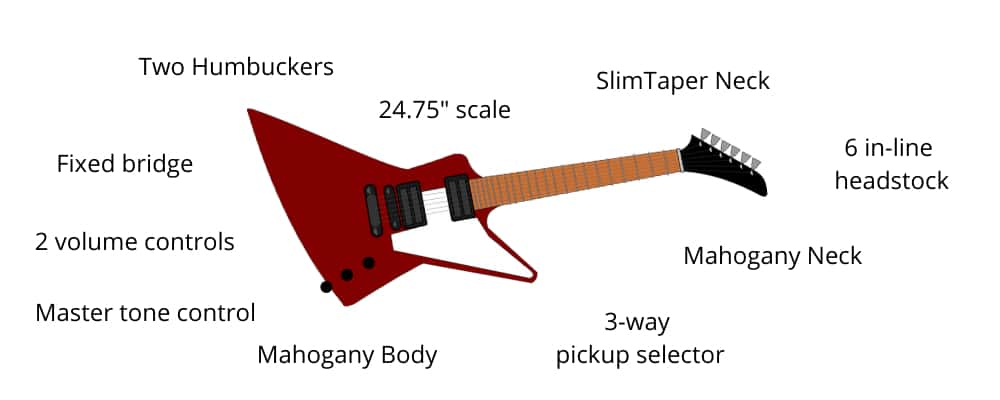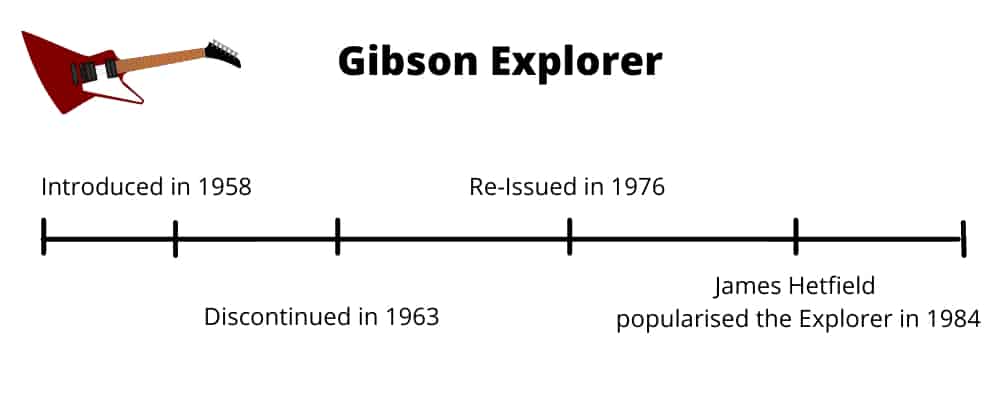The Explorer electric guitar model is not one of the most popular shapes out there, but is very iconic in its own right. The Gibson Explorer was the first model to hit the market, but now more affordable versions by Epiphone are being produced, so it’s much easier to get your hands on one if you’ve got a lower budget.
In this article, I’ll be taking an in-depth look at the Explorer, including its key features, signature tone, playability and the models available at the moment, so you can decide if its the right guitar for you.
What is a Gibson Explorer?
The Gibson Explorer electric guitar was first made in 1958 but became popular in the ’80s. It has a mahogany body and neck, two humbucker pickups, a slim neck and a 24.75″ scale length. The Explorer tone is characteristically dark and powerful, making it popular amongst rock and metal guitarists.
Key Features
First, let’s look at the Gibson Explorer specifications. I’ll also talk more about the rest of the Gibson range, and the Epiphone models later on in the article.
| Feature | Explorer |
| Body Shape | Z-shape |
| Body Wood | Mahogany |
| Pickups | Two Humbuckers |
| Neck Shape | Slim Taper |
| Neck Wood | Mahogany |
| Neck Finish | Gloss |
| Construction | Set-Neck |
| Frets | 22 |
| Fretboard Wood | Indian Laurel |
| Scale Length | 24.75” |
| Bridge | Fixed |
| Pickup Selector | 3-way |
What Does an Explorer Sound Like?
The Explorer has a dark and full tone due to the humbucker pickups and mahogany tone wood. The pickups have a high output, which means it is a loud guitar compared to a lot of other models. Despite being loud and punchy, they are articulate guitars, making it easier to hear notes clearly even when using distortion.
Here are the main design features that help to characterise the Explorer tone:
- High-output dual-humbucker pickup configuration (BurstBucker pickups)
- Mahogany neck and body
- Large and heavy body
Here’s a video where you can hear all the pickups on the Gibson Explorer in action.
Music Styles
The Explorer is commonly associated with metal and heavy classic rock music. This is due to its heavy and punchy tone, which is caused by the BurstBucker (a type of humbucker) pickups, and the mahogany tone woods. The aggressive sound and look of the Explorer makes it well suited to heavier genres.
Compared to the Les Paul?
The Gibson Explorer has a darker and heavier tone with less “attack” compared to a Gibson Les Paul, due to its lack of a maple top. The Explorer has a mahogany body which helps it produce a rich and thick tone, often described as being “fat”.
Controls
Traditional Explorer models have a 3-way pickup selector located on the lower horn of the guitar, close to the neck. This allows you to activate the bridge pickup only, the neck pickup only, or both pickups together. Each pickup has a volume control, and there is a master tone control which can be used to adjust the brightness/ warmth of both pickups.

How Do They Feel to Play?
The Explorer has a slim-tapered neck design, which is designed to be fast, allowing the player to shred, and easily hold barre chords. However, the large body and upper wing, can make it a bit uncomfortable for some players. Although, most players will be able to adapt by simply adjusting the normal position of their strumming hand. It is also a heavy guitar in comparison to most models, meaning it may be a bit unmanageable for some guitarists when playing with the guitar for longer periods of time.
The best thing to do, is to head down to your local guitar store and try it out. Make sure you play the guitar when you’re sitting and stood up, even if you only play primarily in one position, it’s good to get a feel for the guitar and know that you feel comfortable playing both ways.
Can You Play them Sat Down?
You can play an Explorer sat down because it has a deep enough waist to rest on the knee, even though it is not curved. It may start to dig into the thigh when playing for prolonged periods, meaning it is often not the comfiest guitar to play sat down. The upper wing also can get in the way for some players.
Are Explorers Good for Beginners?
Explorers are generally not recommended for beginners because their dramatic shape can be uncomfortable for new guitarists whilst playing sat down. Also, they are quite expensive guitars, with even the more affordable Epiphone Explorer costing over $500, so they are rarely chosen for new players.
Which Brands Make Explorer-Type Guitars?
Explorers were originally produced by Gibson, however their sister brand, Epiphone, now makes affordable versions of the models. Other brands such as Washburn, ESP, BC Rich, Hamer and Jackson have also made guitars similar in shape to the original Gibson Explorer.
I have made this table to compare the features of the standard (non-signature) Gibson and Epiphone Explorer models available currently. The prices are all based on Guitar Center at the time of writing, and the table is ordered from the lowest to the highest price.
| Explorer Model | Origin | Pickups | Finish | Colours | Price |
| Epiphone Explorer | China | ProBucker | Gloss | Black | $600 |
| Gibson Explorer | America | BurstBucker | Gloss | Antique Natural | $1700 |
| Gibson ‘70s Explorer | America | 70’s Tribute BurstBucker | Nitrocellulose lacquer | White | $2000 |
| Gibson Custom Explorer | America | Proprietary Humbucker | Nitrocellulose lacquer | Black | $4700 |
Guitar Center are always the first place I look at when I’m interested in a new electric guitar because have a huge range of models for sale and always have some excellent deals on. Here’s a link to take you directly to Guitar Center’s electric guitar range so you can see all the offers available at the moment.
Brief History of the Explorer
The Gibson Explorer was first made in 1958, the same year as the release of the Flying V. The initial run did not have much success, and the model was discontinued 5 years later in 1963. The model was then re-issued in 1976 by Gibson and became very popular amongst rock and metal guitarists in the 70’s and 80’s.
Who plays a Gibson Explorer?
James Hetfield of Metallica is one of the most famous players known for using a Gibson Explorer on many albums throughout the 80’s. Other guitarists include: Gary Moore, Eric Clapton, Allen Collins, Dave Grohl, Neil Young, and Mattias Jabs.

Frequently Asked Questions
Here are the answers to some common questions you might still have about the Explorer guitar range.
Is an Explorer an offset guitar?
The Explorer is not a traditional offset guitar because it has a symmetrical waist. However, many consider the Explorer to be offset due to its dramatic upper wing which shifts the centre of gravity of the guitar towards the bridge.
How much does an Explorer cost?
Explorer electric guitars range from around $600 to $5000. The version is made by Epiphone’s Inspired by Gibson line of guitars, whilst the traditional Gibson Explorer costs around $1700, or $2000 for the 70’s version. The Custom version is the most expensive and costs between $4500-$5000.
What is the difference between a Flying V and Explorer?
The Flying V and Explorer have radically different body shapes, with the Explorer being the heavier model. The Flying V is often described as more articulate than the Explorer which sounds a bit more aggressive and heavier by comparison.
I’ve written a complete buyer’s guide for electric guitars which takes you through all the things you need to consider and a step-by-step method to narrowing down your selection and choosing the best option. Here is a link to the article.
